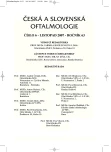Changes of the Thickness of the Ciliary Body after the Latanoprost 0.005 % Applicatio
Authors:
P. Výborný; L. Hejsek; S. Sičáková; J. Pašta
Authors‘ workplace:
Oční klinika 1. lékařské fakulty Univerzity Karlovy a Ústřední
vojenské nemocnice, Praha, přednosta doc. MUDr. Jiří Pašta, CSc.
Published in:
Čes. a slov. Oftal., 63, 2007, No. 6, p. 415-421
Overview
In a randomized prospective open study the authors followed up the influence of latanoprost 0.005 % on the changes of the ciliary body thickness by means of ultrasound biomicroscopy. The study group consisted of 40 eyes of 24 patients with primary open angle glaucoma not treated with latanoprost before. At the entry visit and further after 2 and 8 weeks, according to the study protocol, a complex ophthalmologic examination was performed; especially anatomical relation between the cornea and the iris, configuration of the anterior chamber angle, and furthermore the best visual acuity for far and near, intraocular pressure measurement by means of applanation method, anterior chamber depth, and the pupil size. The thickness of the ciliary body was measured in the distance of 1 500 μm (T1), 2 000 μm (T2), and 2 500 μm (T3) from the scleral spur. A slight decrease of T1 comparing with the initial values was found: from 668 ± 117 μm in the beginning, to 633 ± 127 μm after two weeks, and 614 ± 147 μm after eight weeks of treatment. In the case of T2 measurement, the situation is similar; the decrease of the values was smaller than in T1. The above-mentioned differences were not statistically significant. Practically no differences were found in the T3 measured values. The intraocular pressure during the follow-up decreased markedly – from 21.3 ± 4.2 mm Hg to 18.8 ±3.3 mm Hg (week 2) and 17.6 ± 3.7 mm Hg (week 8). The average lowering of the intraocular pressure (IOP) by 2.5 mm Hg (i.e. by 11.7 %) found between the initial values and values after two weeks of treatment was found as statistically significant (P-value = 0.0001) as well as the difference between the initial values and values after eight weeks of treatment. No statistical significant difference was found between IOP values measured after two and eight weeks of treatment. All other followed-up parameters (anterior chamber depth, size of the pupil, visual acuity, and external finding) remained during the eight weeks period unchanged.
Our results are in the congruity with one of hypotheses of the latanoprost acting – compacting of the interstitium and following opening of the porosities among the muscles fibers bundles of the ciliary body cause the increase of the intraocular fluid outflow and marked decrease of the intraocular pressure. To explain the mechanisms affecting the ciliary body in detail, more studies are needed.
Key words:
ciliary body, glaucoma, latanoprost, ultrasound biomicroscopy
Labels
OphthalmologyArticle was published in
Czech and Slovak Ophthalmology

2007 Issue 6
Most read in this issue
- Opacification of Hydrophilic Acrylic Intraocular Lenses
- Dry Eye Syndrome in Rheumatoid Arthritis Patients
- Correlation of the Heidelberg Retinal Tomograph, Evaluation of the Retinal Nerve Fiber Layer and Perimetry in the Diagnosis of Glaucoma
- Posterior Capsule Opacification (PCO) Following Implantation of Various Types of IOLs – Part One: The Uncomplicated Course
